Introduction to Technical Writing
Introduction to Technical Writing. <(“<) <( “ )> (>”)>. Jonathan Frishman. TEKS Objectives. (1) The student writes for a variety of purposes and audiences. (2) The student selects and uses recursive writing processes for self-initiated and assigned writing.
Share Presentation
Embed Code
Link
Download Presentation
- writing
- written english
- sentence structure
- effective writing
- recursive writing processes
- rules tac chapter110 ch110c

owen-clark + Follow
Download Presentation
Introduction to Technical Writing
An Image/Link below is provided (as is) to download presentation Download Policy: Content on the Website is provided to you AS IS for your information and personal use and may not be sold / licensed / shared on other websites without getting consent from its author. Content is provided to you AS IS for your information and personal use only. Download presentation by click this link. While downloading, if for some reason you are not able to download a presentation, the publisher may have deleted the file from their server. During download, if you can't get a presentation, the file might be deleted by the publisher.
Presentation Transcript
- Introduction to Technical Writing(>”)> Jonathan Frishman
- TEKS Objectives (1) The student writes for a variety of purposes and audiences. (2) The student selects and uses recursive writing processes for self-initiated and assigned writing. (3) The student writes to investigate self-selected and assigned topics. (4) The student applies the conventions of usage and mechanics of written English. (5) The student evaluates his/her own writing and the writing of others.
- The study of technical writing allows you to: • Developing skills necessary for writing persuasive and informative texts such as essays, reports, proposals, and memoranda. • Demonstrate an understanding of the recursive nature of the writing process, effectively applying the conventions of usage and the mechanics of written English. • Evaluate your own writing as well as the writing of others to insure that you are able to analyze and discuss published and unpublished pieces of writing, develop and apply criteria for effective writing, and set your own goals as writers.
- Part I (1) Writing for a variety of purposes and audiences. (2) Selecting and using recursive writing processes for self-initiated and assigned writing.
- Writing for a variety of purposes and audiences. • Write informative and persuasive texts, including essays, reports, and proposals. In a variety of fields in the real world, a person might write a research paper to document results of an experiment, or to bring to attention the history of something. It isn’t just for school. Politicians submit bills in this form, and administrators compile reports shedding light as to how a particular program is working.
- Writing for a variety of purposes and audiences. • Use the distinguishing characteristics of various written forms such as essays, scientific reports, speeches, and memoranda. As there many reasons for writing a research paper, there are also multiple ways to form it. The different fields in which we may be submitting the reports call for a certain type of layout which we will discuss in detail during the semester.
- Writing for a variety of purposes and audiences. (C) Write in voice and style appropriate to audience and purpose. Always to be taken into consideration are the people to whom you are addressing with your writings. Think about the age/gender/education/cultural or ethnic background/etc. The usage of specific wording and phrasing can be more appealing, or understandable based on how you write. Think about propaganda for example. Is that tapered towards a specific audience?
- Adolf Hitler’s Use of Propaganda
- Adolf Hitler’s Use of Propanda Hitler wrote and spoke in a way that incited common Germans into a spiral of intolerance and uniformity. This illustrates in a very negative way the power writing have on its readers.
- Writing for a variety of purposes and audiences. (D) Organize ideas in writing to ensure coherence, logical progression, and support for ideas. Having your writings be clear, and progressive keeps the reader’s attention, and ensures retention will be higher. Scattered thoughts can derail effective reading, and cause the mind to wander, get confused, or completely reject your work. Keep it simple, and coherent. Good transitions between paragraphs are especially important.
- Selecting/Using recursive writing processes. (A) Select and apply prewriting strategies to generate ideas, develop voice, and plan. Create an outline, research your subject well, keep your notes and documentations well organized throughout your search. Also, the use of graphic organizers such as a Venn diagram can bolster the thought process, and help you to write in a coherent way. Avoid the crashing waves method of writing, in which you flow in, crumple up the page, recede from the shore, and wash back in towards the beach again.
- Selecting/Using recursive writing processes. (B) Employ precise language and technical vocabulary to communicate ideas clearly and concisely. In order to be understood, and not misinterpreted, you should choose vocabulary that is descriptive of what you are trying to convey without sounding like a lot of hot air. opprobrious salubrious perspicacity lassitude acarpous gaucherie proclivity superfluous ineluctable mendacity phlegmatic quiescence
- Selecting/Using recursive writing processes. (C) Use sentence structure, organization, and rhetorical devices appropriate to audience and purpose. This relates much to the point discussed earlier regarding how to address your audience. Correct sentence structure, as well as good organization can ensure that your words can be comprehensible to the largest spread of readers. Rhetorical devices, such as allusion, and metaphors bring to mind memories, or imagery that can be easily understood and remembered.
- Selecting/Using recursive writing processes. (D) Use effective sequence and transitions to achieve coherence and meaning. Sequence: A following of one thing after another; succession. An order of succession; an arrangement. Transitions: Passage from one form, state, style, or place to another. Passage from one subject to another in discourse. A word, phrase, sentence, or series of sentences connecting one part of a discourse to another.
- Selecting/Using recursive writing processes. (E) Revise drafts by rethinking content, organization, and style to better accomplish the task. (F) Proofread and edit as appropriate for the conventions of standard written English.
- Selecting/Using recursive writing processes. (G) Use resources such as texts and other people for editing. An essential part of any research paper is the usage of outside sources which support the points you are making. The more tested, and proven of points giving you a better foundation for the assertions you will make. Our personal, and empirical evidence alone does not stand up to trial always.
- Selecting/Using recursive writing processes. (H) Use available technology for aspects of creating, revising, editing, and publishing texts. At our disposal, we now have many programs that can smoothen the process by which we write. Microsoft Word, for example, has thesaurus, spelling, and grammar tools that help to keep us in check. Additionally, the internet has many sources of material for use in a report. The trick is validity.
- Selecting/Using recursive writing processes. (I) Write both independently and collaboratively. Most of what you will encounter in writing research topics is generally independent. However, there will come times, particularly in the job environment, when you will be asked to present reports based on collaborative efforts. Being able to work with others is not always easy, rather it is an acquired talent, so work at it diligently.
- Continued in Part II… (3) The student writes to investigate self-selected and assigned topics. (4) The student applies the conventions of usage and mechanics of written English. (5) The student evaluates his/her own writing and the writing of others.
- Sources • Texas Essential Knowledge and Skills for English Language Arts and Reading. Retrieved from http://www.tea.state.tx.us/rules/tac/chapter110/ch110c.html. • EarthStation1.com - The WWII Sounds & Pictures Page - Wavs, Images and Videos of Adolf Hitler. Retrieved from http://www.earthstation1.com/Hitler.html
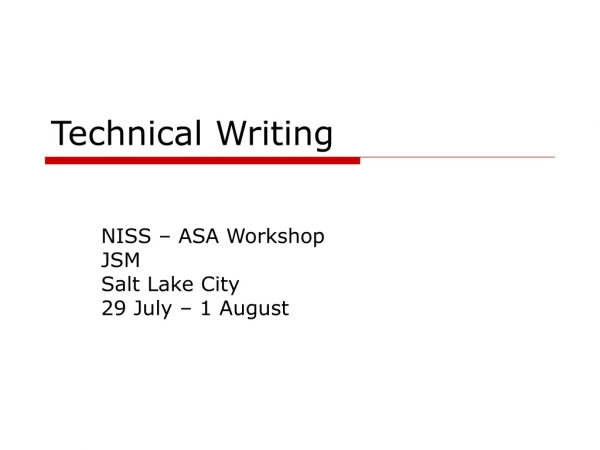
Technical Writing
Technical Writing. NISS – ASA Workshop JSM Salt Lake City 29 July – 1 August. Writing for a Technical Audience. Purpose: To Inform Aspects Structure Choice of Material Organization of Ideas Depth of Detail Style Grammatical Structure Word Choice Caveat : Don’t Lose the Reader!.
1.17k views • 14 slides
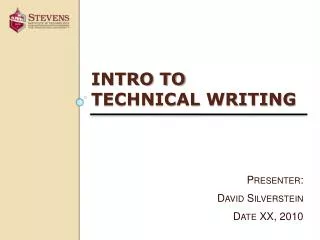
INTRO to Technical writing
Presenter: David Silverstein Date XX, 2010. INTRO to Technical writing. Overview. 50-min Presentation (with Q&A) The Writing & Communications Center Technical Writing Considerations Rhetoric & the Rhetorical Triangle Writing Process & Technical Considerations
1.01k views • 78 slides

Technical writing
Technical writing. October 24 th , 2012. Today. Thank you letter Language focus. Last class: Business letters. Formal, official business communications. Common types of business letters. Inquiry letters (asking for information). Cover letters (accompany documents like proposals).
538 views • 21 slides
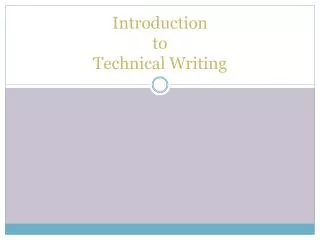
Introduction to Technical Writing
Introduction to Technical Writing. Why Technical Writing?. In industry, 20-40% of your time will be writing Career advancement People judge by communication skills Many job profiles requires versatility (more varied responsibilities). Definition of Technical Writing.
403 views • 12 slides

Technical Writing:
Technical Writing:. Writing on the Job Site!. Technical Writing . You already know that technical writing is informational writing that is used in the business world . This type of writing gives instructions or provides information about a product, service, or task.
443 views • 9 slides

Technical writing
Technical writing. December 10, 2013. Today. Improving Writing Clarity: - Pronoun reference. Word Choice (WC) Error Exercises. 1. If you keep the current catered operation, your contribution margin after taxes will be $12,000.
754 views • 52 slides

Technical writing
Technical writing. November 19 , 2012. Today. Intro to short reports (proposals) . Tone Exercises. 1. Northern must ask for help from Vardizon . - This is an order. - “ask” & “help” are informal terms. Northern should request assistance from Vardizon . Tone Exercises.
743 views • 52 slides

Technical writing
Technical writing. November 28 th , 2012. Today. Presenting a proposal. Giving an effective presentation. K I S S. eep t imple tupid. Giving an effective presentation. If you follow a SIMPLE , organized presentation style, you will be more successful than most presenters.
422 views • 25 slides

Technical writing
Technical writing. November 14 th , 2012. Today. Short Reports: Proposals (Internal Proposals). Short report. Also known as “informal” or “semiformal” report. A short report is an organized presentation of relevant info/data on any topic. Types of Short Reports.
932 views • 59 slides

TECHNICAL WRITING
TECHNICAL WRITING. WHAT IS TECHNICAL WRITING?. Fundamental skill for everyone working in science and engineering Technical report is a major form of communication Most science and engineering activities produce technical reports Government and commercial activities involving Research
656 views • 23 slides

Technical Writing
Technical Writing. Types Modes Content Writing. Nobody reads documentation. – Mark Rettig, CACM, 1991. Technical Writing: Exercises. Go to the classroom with your smart phone. CS 262 should not be taken.
1.35k views • 32 slides
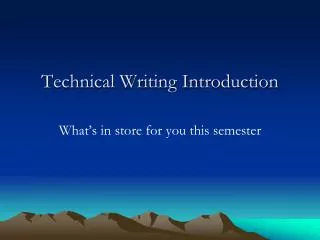
Technical Writing Introduction
Technical Writing Introduction. What’s in store for you this semester. Contents . Purpose of course Technical writing characteristics Technical writing Course requirements Safe computing. Definition/Purpose of Course.
543 views • 11 slides

Technical Writing
Technical Writing. Publish, Why?. Communicate new knowledge Receive recognition Get feedback. Publish, Where?. Conferences - Some are more prestigious than conferences Quick feedback More relevant material Posters More exposure Less Prestigious Journals Longer review cycle
386 views • 12 slides

Technical writing
Technical writing. September 13, 2013. Today. Wrap-up the writing process Memos. Review – The Writing Process. Step 1: Brainstorming & Planning Step 2: Drafting (write a rough draft) Step 3: Revising Step 4: Editing. Step 3: Revising. “Rethinking”
945 views • 48 slides
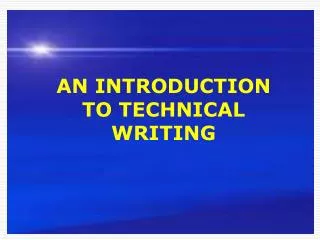
AN INTRODUCTION TO TECHNICAL WRITING
AN INTRODUCTION TO TECHNICAL WRITING. The Definition of Technical Writing. The written communication of engineering and scientific ideas, concepts and data presented objectively, logically and accurately. The writing is clear and concise
5.31k views • 15 slides
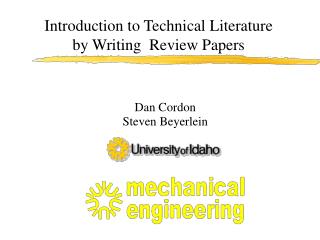
Introduction to Technical Literature by Writing Review Papers
Introduction to Technical Literature by Writing Review Papers. Dan Cordon Steven Beyerlein. Technical Elective courses feature specialized knowledge Design is a central function in engineering practice Research efforts often superficial in design projects
309 views • 12 slides

Technical writing
Technical writing. October 5 th , 2012. Today. E-mails. E-Mail. One of the most common forms of workplace communication. - Within organizations. - Between organizations. E-Mail. Think of work e-mail as a polite, informative, and friendly conversation. E-Mail.
560 views • 41 slides

Technical writing
Technical writing. November 30 th , 2012. Today. Gestures. Making effective PowerPoints. Presentation Skills: Gestures. A gesture = “a hand movement that is just as much a part of language as speech.” It you give your presentation like this:
765 views • 50 slides

Introduction to Technical and Business Writing
Introduction to Technical and Business Writing. What is Technical Writing?. Taking complicated subject matter and transforming it into easy-to-understand information for the reader. Why do we need technical communication?.
986 views • 28 slides

Technical Writing
Technical Writing. Guidelines. General Issues. Why a lecture about writing?. Surely, any literate can write. Why talk about ‘Writing’?. Any body can sing. But, can we get an audience? Writing is for communication? Can we get readers?. ‘Writing’ is a SKILL.
964 views • 75 slides

Introduction to Technical Writing
Introduction to Technical Writing. Good Style Building goodwill Half Truths About Writing Better Style 11 Ways to Build Better Style Draft Testing Organizational Preferences Recommended Resources. Contact Information and Office Hours. Ms. Jessica Ponto J.J.Ponto@Utah.edu
517 views • 37 slides

Technical Writing
Technical Writing. Definition Goals Writing Process. What is Technical Writing?.
1.13k views • 31 slides
























